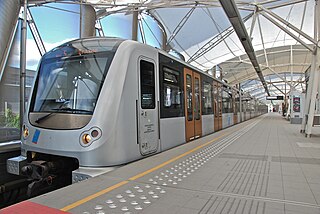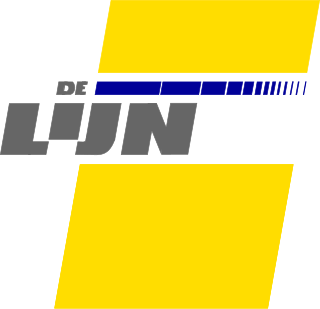
Transport in Belgium is facilitated with well-developed road, air, rail and water networks. The rail network has 2,950 km (1,830 mi) of electrified tracks. There are 118,414 km (73,579 mi) of roads, among which there are 1,747 km (1,086 mi) of motorways, 13,892 km (8,632 mi) of main roads and 102,775 km (63,861 mi) of other paved roads. There is also a well-developed urban rail network in Brussels, Antwerp, Ghent and Charleroi. The ports of Antwerp and Bruges-Zeebrugge are two of the biggest seaports in Europe. Brussels Airport is Belgium's biggest airport.

The Brussels Metro is a rapid transit system serving a large part of the Brussels-Capital Region of Belgium. It consists of four conventional metro lines and three premetro lines. The metro-grade lines are M1, M2, M5, and M6 with some shared sections, covering a total of 39.9 kilometres (24.8 mi), with 59 metro-only stations. The premetro network consists of three tram lines that partly travel over underground sections that were intended to be eventually converted into metro lines. Underground stations in the premetro network use the same design as metro stations. A few short underground tramway sections exist, so there is a total of 52.0 kilometres (32.3 mi) of underground metro and tram network. There are a total of 69 metro and premetro stations as of 2011.

Berchem is a southern district of the municipality and city of Antwerp in the Flemish Region of Belgium. Berchem is located along the old Grote Steenweg that has connected Brussels to Antwerp for several centuries; the town borders the districts of Deurne, Borgerhout, Wilrijk and Antwerp and the municipality of Mortsel. Berchem itself consists of three quarters, Oud Berchem, Groenenhoek and Nieuw Kwartier.

Vlaamse Vervoersmaatschappij De Lijn, usually known as De Lijn, is a company run by the Flemish government in Belgium to provide public transportation with about 2240 buses and 399 trams. De Lijn was founded in 1991 after the public transportation companies of Antwerp and Ghent fused with the Flemish part of the NMVB.

The National Company of Light Railways was a state-owned transportation provider which comprised a system of narrow-gauge tramways or local railways in Belgium, which covered the whole country, including the countryside, and had a greater route length than the mainline railway system. They were 1,000 mmmetre gauge and included electrified city lines and rural lines using steam locomotives and diesel railcars; half the system was electrified.

The Brussels tramway network is a tram system serving a large part of the Brussels-Capital Region of Belgium. It is the 16th largest tram system in the world by route length, in 2017 providing 149.1 million journeys over routes 140.6 km (87.4 mi) in length. In 2018, it consisted of 18 tram lines. Brussels trams are operated by STIB/MIVB, the local public transport company.

The Coast Tram is a public transport service connecting the cities and towns along the Belgian coast between De Panne, near the French border, and Knokke-Heist, near the Dutch border. At 67 kilometres (42 mi) in length, it is currently the world's longest metre gauge tram line in service, and the second-longest light rail service in the world after the A Line of the Los Angeles Metro Rail system, as well as one of the few interurban tramways in the world to remain in operation. The line is fully electrified at 600 V DC.

Opérateur de transport de Wallonie (OTW), formerly Société régionale wallonne du transport (SRWT), is responsible for the supervision, strategic planning and marketing of a group of five regional public transport directorate branded as TEC or "Transport En Commun" in Wallonia, Belgium. It is primarily a bus operator, but also operates the Charleroi tram system, and will operate the tramway in Liège once completed. TEC buses and trams are distinctively painted yellow and red.

The Antwerp premetro tram route 3 is a tram route connecting Merksem with Melsele in the city of Antwerp. The route is operated by the Flemish transport company De Lijn and historically also by its Antwerp predecessor, MIVA.

The Warsaw tram network is a 125.3-kilometre (77.9 mi) tram system serving a third of Warsaw, Poland, and serving half the city's population. It operates 726 cars, and is the second-largest system in the country. There are about 25 regular lines, forming a part of the city's integrated public transport system organized by the Warsaw Transport Authority. Since 1994 the system is operated by the municipally-owned company Tramwaje Warszawskie sp. z.o.o.

The Ghent tramway network is a network of tramways forming part of the public transport system in Ghent, a city in the Flemish Region of Belgium, with a total of four lines. Since 1991, the network has been operated by De Lijn, the public transport entity responsible for buses and trams in Flanders.

The Antwerp tramway network is a network of tramways forming part of the public transport system in Antwerp, a city in the Flemish Region of Belgium. The network is operated by the Flemish region's transportation company De Lijn. As of April 2017, it featured fourteen lines, eight of which pass partially underground.

Brussels has an extensive network of both private or public transportation means. Public transportation includes Brussels buses, trams, and metro, as well as a set of railway lines and railway stations served by public trains. Air transport is available via one of the city's two airports, and boat transport is available via the Port of Brussels. Bicycle-sharing and car-sharing public systems are also available. The city is relatively car-dependent by northern European standards and is considered to be the most congested city in the world according to the INRIX traffic survey.

Bockstael railway station is a railway station in Brussels, Belgium, operated by the National Railway Company of Belgium (NMBS/SNCB). It opened in 1982 to replace Laeken railway station.

The Düsseldorf tramway network is a network of tramways serving Düsseldorf, the capital city of the federal state of North Rhine-Westphalia, Germany. In combination with the Düsseldorf Stadtbahn and Rhine-Ruhr S-Bahn, it forms the backbone of the public transport system in Düsseldorf.
The Hasselt – Maastricht tramway was a proposed light rail system linking Hasselt, Belgian province of Limburg and Maastricht, Dutch province of Limburg. The project was part of the Spartacusplan of Belgian Limburg, proposed by the Belgian transport company De Lijn, with the aim of improving the province's transport links. The tramway's opening was originally scheduled for 2017, then postponed until 2025. It was finally cancelled on 10 June 2022 in favour of an electric "trambus".

Blankenberge railway station is a railway station in Blankenberge, West Flanders, Belgium. The station opened on 16 August 1863 on railway line 51. It is run by the National Railway Company of Belgium (NMBS/SNCB) as a terminal station located on the railway line from Brugge and has services to Brussels-South and beyond to Leuven.
Transport in Flanders is run in two levels regarding the federal nature of Belgium with certain functions run on behalf of the national Cabinet of Belgium and other functions run on behalf of Flemish Government. Therefore, the railways are run at national level by NMBS and are under the auspices of the Cabinet of Belgium, whilst the light railways are run at regional level by De Lijn under the auspices of the Flemish Government. The railway infrastructure is managed by Infrabel and thus is under the auspices of the Cabinet of Belgium.
Tram Route 10 is a tram route in Antwerp and nearby Wijnegem. Tram route 10 entered operation in 1873, making it one of the oldest tram routes still active in Antwerp, next to Tram Route 4 (Antwerp) and Tram Route 7 (Antwerp).














